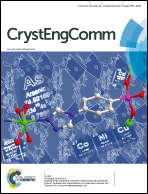Two low-dimensional Schiff base copper(i/ii) complexes: synthesis, characterization and catalytic activity for degradation of organic dyes†
Abstract
Two low-dimensional oxime-containing Schiff base copper(I/II) complexes with iodine–copper cluster [Cu2I4]2− bridges, namely, {[CuII4I3(pop)4]2(CuI2I4)}·(CH3CN)2·H2O (2) and [CuII4I2(pop)4(CuI2I4)·(CH3CN)]n (3) (Hpop = 2-(hydroxyimino)-N′-[1-(2-yridyl)ethylidene]propanehydrazone), have been synthesized from the reaction of [2 × 2] grid-like compound {[CuIII(pop)]4}2·4H2O (1) with equivalent CuI2I2 (iodine–copper clusters) under solvothermal conditions and characterized by elemental analysis (EA), infrared spectroscopy (IR), thermogravimetric analysis (TGA), and X-ray single-crystal/powder diffraction. The results show that 2 is a 0-D discrete structure from an assembly of one [Cu2I4]2− unit and two [2 × 2] molecular grids (1) via μ3-I atoms coordinating to CuI/CuII atoms. However, compound 3 presents a 1-D wave-like chain, which is constructed by coordination of μ2-I atoms from [CuI2I4]2− units with CuII atoms in [2 × 2] molecular grids (1). Moreover, catalytic experiments demonstrated that compounds 2 and 3 have promising visible-light-driven catalytic activity in degrading various organic dyes.


 Please wait while we load your content...
Please wait while we load your content...